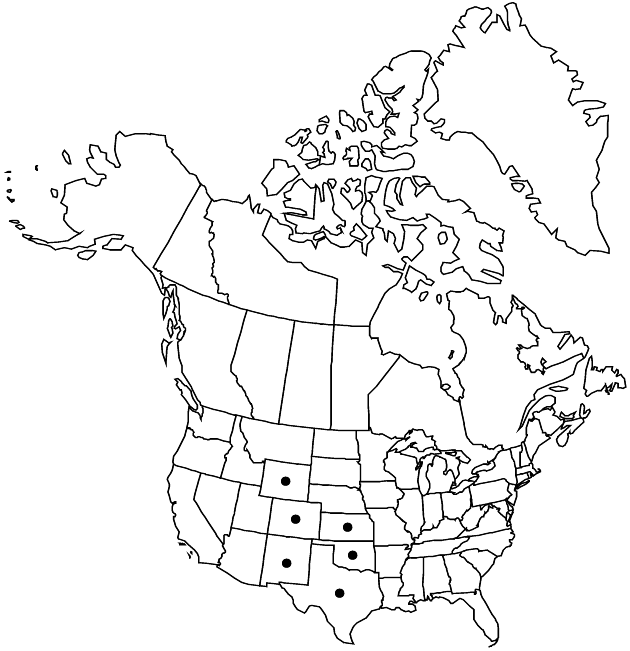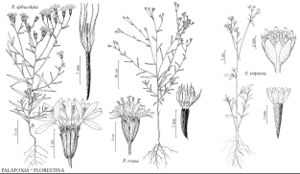Difference between revisions of "Palafoxia rosea"
Rhodora 48: 86. 1946.
FNA>Volume Importer |
imported>Volume Importer |
||
| (6 intermediate revisions by 2 users not shown) | |||
| Line 7: | Line 7: | ||
|year=1946 | |year=1946 | ||
}} | }} | ||
| − | |basionyms={{Treatment/ID/ | + | |special_status={{Treatment/ID/Special_status |
| + | |code=F | ||
| + | |label=Illustrated | ||
| + | }}{{Treatment/ID/Special_status | ||
| + | |code=E | ||
| + | |label=Endemic | ||
| + | }} | ||
| + | |basionyms={{Treatment/ID/Basionym | ||
|name=Othake roseum | |name=Othake roseum | ||
|authority=Bush | |authority=Bush | ||
| + | |rank=species | ||
| + | |publication_title=Trans. Acad. Sci. St. Louis | ||
| + | |publication_place=14: 175. 1904 | ||
}} | }} | ||
|synonyms={{Treatment/ID/Synonym | |synonyms={{Treatment/ID/Synonym | ||
|name=Palafoxia rosea var. macrolepis | |name=Palafoxia rosea var. macrolepis | ||
|authority=(Rydberg) B. L. Turner & M. I. Morris | |authority=(Rydberg) B. L. Turner & M. I. Morris | ||
| + | |rank=variety | ||
}} | }} | ||
|hierarchy=Asteraceae;Asteraceae tribe Heliantheae;Asteraceae (tribe Heliantheae) subtribe Chaenactidinae;Palafoxia;Palafoxia rosea | |hierarchy=Asteraceae;Asteraceae tribe Heliantheae;Asteraceae (tribe Heliantheae) subtribe Chaenactidinae;Palafoxia;Palafoxia rosea | ||
| Line 29: | Line 40: | ||
|elevation=100–1500 m | |elevation=100–1500 m | ||
|distribution=Colo.;Kans.;N.Mex.;Okla.;Tex.;Wyo. | |distribution=Colo.;Kans.;N.Mex.;Okla.;Tex.;Wyo. | ||
| − | |discussion=<p>Plants of Palafoxia rosea with phyllaries 7–10 (versus 5–7) mm and pappus scales 3–8 (versus 1–3) mm have been treated as var. macrolepis. Some specimens are not readily assignable to either variety, and some are not readily assignable to either P. rosea or P. texana. Other specimens referred here to P. rosea closely resemble P. callosa.</p> | + | |discussion=<p>Plants of <i>Palafoxia rosea</i> with phyllaries 7–10 (versus 5–7) mm and pappus scales 3–8 (versus 1–3) mm have been treated as var. macrolepis. Some specimens are not readily assignable to either variety, and some are not readily assignable to either <i>P. rosea</i> or <i>P. texana</i>. Other specimens referred here to <i>P. rosea</i> closely resemble <i>P. callosa</i>.</p> |
|tables= | |tables= | ||
|references= | |references= | ||
| Line 38: | Line 49: | ||
-->{{#Taxon: | -->{{#Taxon: | ||
name=Palafoxia rosea | name=Palafoxia rosea | ||
| − | |||
|authority=(Bush) Cory | |authority=(Bush) Cory | ||
|rank=species | |rank=species | ||
| Line 52: | Line 62: | ||
|publication title=Rhodora | |publication title=Rhodora | ||
|publication year=1946 | |publication year=1946 | ||
| − | |special status= | + | |special status=Illustrated;Endemic |
| − | |source xml=https:// | + | |source xml=https://bitbucket.org/aafc-mbb/fna-data-curation/src/2e0870ddd59836b60bcf96646a41e87ea5a5943a/coarse_grained_fna_xml/V19-20-21/V21_985.xml |
|tribe=Asteraceae tribe Heliantheae | |tribe=Asteraceae tribe Heliantheae | ||
|subtribe=Asteraceae (tribe Heliantheae) subtribe Chaenactidinae | |subtribe=Asteraceae (tribe Heliantheae) subtribe Chaenactidinae | ||
Latest revision as of 20:15, 5 November 2020
Annuals, 10–50 cm. Stems scabrous to glabrate, not stipitate-glandular. Leaf blades linear-lanceolate, 30–60 × 2–6(–10) mm. Involucres ± turbinate. Phyllaries 5–10 × 1–2.5 mm, ± equal, usually scabrellous and stipitate-glandular. Ray florets 0. Disc florets 5–30; corollas actinomorphic, 7–10 mm, throats ± funnelform, shorter than lobes. Cypselae 5–8 mm; pappus scales of inner cypselae (1.5–)3–8 mm. 2n = 20.
Phenology: Flowering spring–fall.
Habitat: Sandy soils
Elevation: 100–1500 m
Distribution

Colo., Kans., N.Mex., Okla., Tex., Wyo.
Discussion
Plants of Palafoxia rosea with phyllaries 7–10 (versus 5–7) mm and pappus scales 3–8 (versus 1–3) mm have been treated as var. macrolepis. Some specimens are not readily assignable to either variety, and some are not readily assignable to either P. rosea or P. texana. Other specimens referred here to P. rosea closely resemble P. callosa.
Selected References
None.
